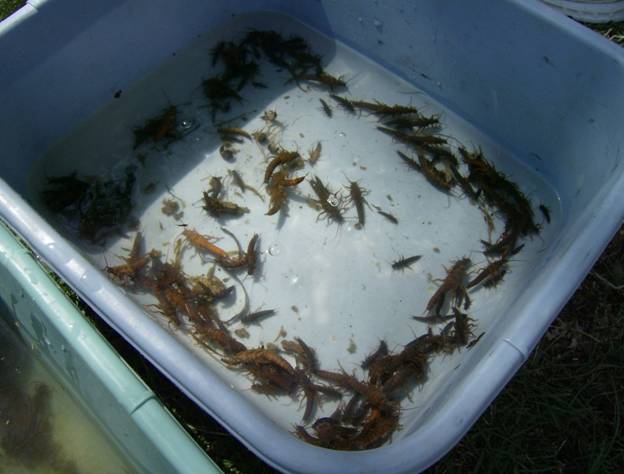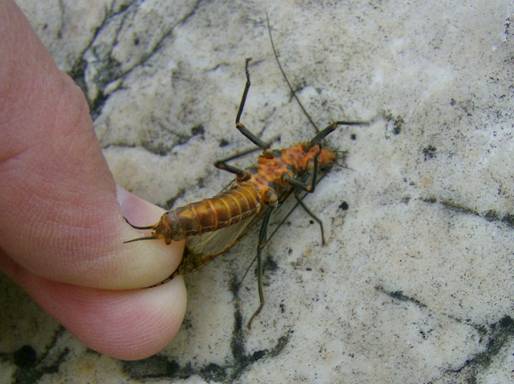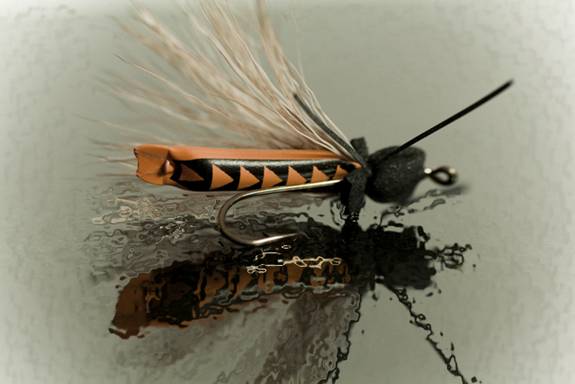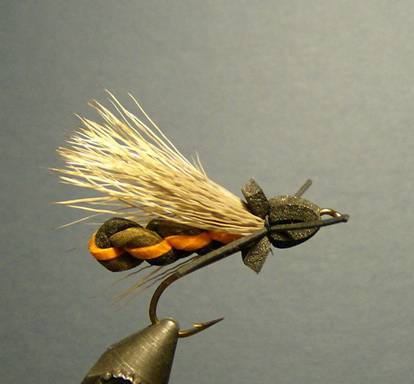THOSE BIG BUGS!

“Have you been to the river? Are the big stoneflies hatching yet?” Those two questions start to fly through the networks of computer emails, text messages, cell phone calls, and conversations in fly shops starting in May and continuing into the middle of July in many western states. Every year fly fishers look for, wait for, and try to hit the Pteronarcys californica hatch, or as it is known commonly: the salmonfly, giant stonefly, or those big bugs!

Stonefly time is a time of wide-eyed, half crazed enthusiasm for some fly anglers. When the word goes out that the bugs are hatching, normal behavior and sometimes caution is thrown to the wind. As stonefly nymphs change into adult form, it seems that some fly fishers do the opposite and go from grown men to acting like kids. But that’s okay, chasing the hatch is part of the fun, and as many can attest, fly fishing has a way of making all of us feel younger.
While many fly fishers chomp at the bit each year looking for stonefly hatches, it seems some of the older veterans of this hatch are leaving all the heart-racing enthusiasm and mouth drooling to the new uninitiated fly fishers. In fact, many who have chased this hatch for years just don’t get all that excited, and some are even calling the hatch overrated.
On an on-line fly fishing forum, I asked anglers how they felt about the big stonefly hatch. I never received a lot of response. Maybe because the stoneflies are just starting to hatch on my local Utah waters and the “nuts” are out fishing instead of sitting home answering forum questions about insects. I have monitored several sites and can tell from reports that there are definitely two camps when it comes to opinions about stonefly hatches. Some attack the hatch with a frenzied attitude, while others don’t necessarily do a river jig over the big bugs. A few anglers feel like the stonefly hatches on the smaller waters are overrated, but still feel the fabled waters in the Northwest and west are worth a trip when the hatch is on. This, in part, is due to the size of fish available on the fabled waters.
Year after year, tips to having a successful stonefly outing are rehashed in magazine articles. There really are no secrets. The number one key to success is to be one the water with a decent stonefly nymph and dry fly pattern with good water and weather conditions—the good weather and water conditions being more important.
Here are seven things that can hinder or help when fishing a stonefly hatch:
Run off. It is not uncommon to run into high, and often times off-colored water conditions during a stonefly hatch. Sometimes the water condition is not conducive to having a good experience. You can try to fish side channels, eddies and slower flood areas near the banks, but sometimes you just have to wait for better conditions or search for other waters.
Cold, wet weather can put the hatch off for a couple of weeks. Warm dry weather can bring the hatch early. Being able to watch the water on a daily basis is beneficial. If you can’t watch daily, then tying into the “network” (computer forum reports, emails, cell phone calls, and shop talk) are ways to be informed.
Fish nymphs. Fish them before the hatch, during the hatch, and after the hatch.
Breezy conditions may help with dry fly success. Winds may knock the migrating stones into the water as well as some of the bugs moving around on the streamside brush.
The best time to look for dry fly action is when the adults, particularly, the egg carrying females are migrating up river and dropping their egg mass.
Watch the birds. Birds will climb around the brush and willows looking for an easy meal or fly out over the water to pick a flying stonefly out of the air. They are not always successful at catching the bugs and will knock some of them in the water.

A large dry fly imitation can be fished for a few weeks after the bugs are gone. Some fly anglers find better success with the large dries a week or two after the hatch is over and other anglers have left the area. In my experience, this is a great time to fish a large dry. I think the fish are less spooky and still remember and relish eating the big morsels.

Everyone should have a chance to chase a big stonefly hatch. After all these years, it still gets my adrenaline racing. Even when the fishing conditions are not optimal, I like to see the bugs near the river and will go looking for them. Knowing they are still there gives me an added measure of serenity in my life. I guess it’s like visiting an old friend.
Robert Williamson lives in Roy, Utah. He chases stonefly hatches every year. His articles have appeared in Fly Fishing & Tying Journal, Northwest Fly-fishing and Utah outdoors. He is the author of Creative Flies: Innovative Tying Techniques, Frank Amato Publications.
